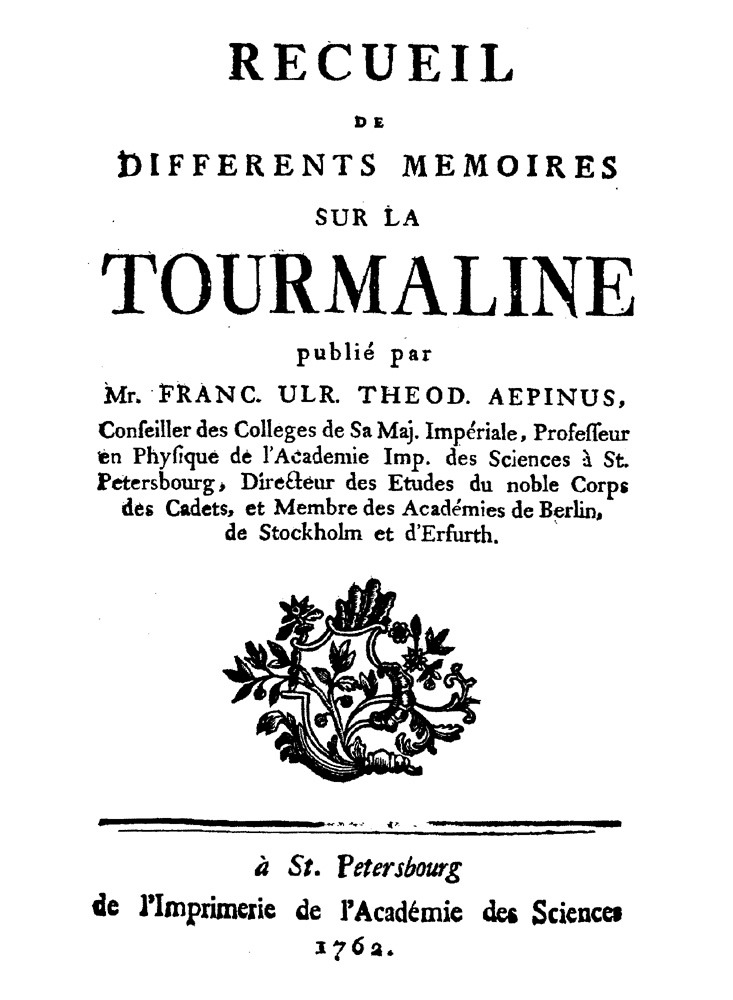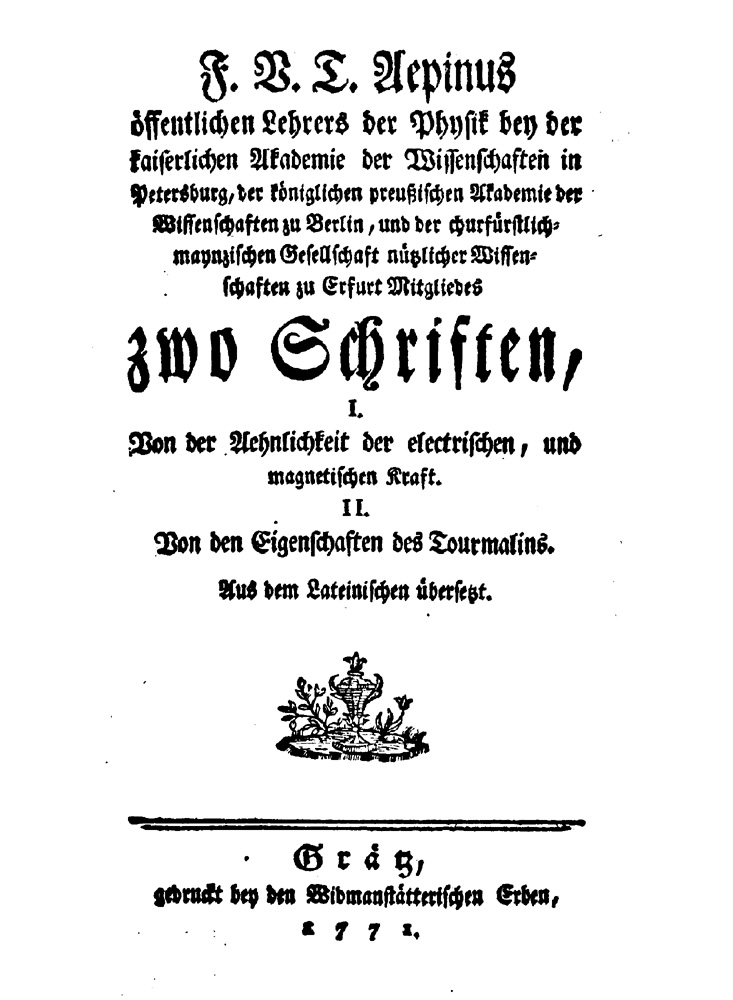AEPINUS, Franz U. T.
(1724 – 1802)
Aepinus studied medicine and mathematics at Jena and Rostock, where he took his M.A. in 1747, with his dissertation on the paths of falling bodies. In 1757, he settled in St. Petersburg, where he had become a member of the Academy of Sciences in 1755, as well as a professor of physics. He possessed great skill as an experimenter, which he applied to discovering and testing the electrical properities of tourmaline. He was particularly struck by the similarity between the magnet and the tourmaline with regard to polarity. He authored, Tentamen Theoriæ Electritaitis et Magnetismi (1759), "one of the most original and important books in the history of electricity. It is the first reasoned, fruitful exposition of electrical phenomena based on action-at-a-distance" (DSB).
Biographical references: ADB. • DBA: I 7, 338-350; II 11, 282-285. • DSB: 1, 66-8 [by J.L. Heilbron]. • Hamberger & Meusel, Gelehrte Teutschland, 1796-1834. • Hirsch, Biographisches Lexikon, 1884-8. • NDB. • Poggendorff: 1, cols. 14-15. • Thomas, Dictionary of Biography, 1884: 59. • WBI. • Webster's Biographical Dictionary: 14. • World Who's Who in Science: 15.

1. French, 1762 [First edition].
Recueil | De | Differents Memoires | Sur La | Tourmaline | publié par | Mr. Franc. Ulr. Theod. Aepinus, | [...5 lines of titles and memberships...] | [ornament] | [double rule] | à St. Petersbourg | de l'Imprimerie de l'Académie des Sciences | 1762.
8°: )(8 A-M8 )()(1; 99l.; [16], [1]-179, [3] p., illus. Page size: 222 x 142 mm. uncut.
Contents: [2 pgs], Title page, verso blank.; [6 pgs], Dedication to Catherine Alexievna, signed F.V.T. Aepinus, 13 July 1762.; [8 pgs], "Avant-Propos."; [1]-179, Text.; [1 pg], Blank.; [2 pgs], "Table | des Pieces conténues | dans ce Recueil."
Rare. A reprint of the author's original paper on tourmaline, "Mémoires concernant quelques nouvelles expériences électriques remarquables" (see: Histoire de l'Académie Royale des Sciences et Belles Lettres, Berlin, 12, 1756), providing additional detail concerning his experimental procedures. In addition, Benjamin Wilson's "Experiments on the Tourmalin" (Philosophical Transactions of the Royal Society of London, 51, 1759) and Duke de Noya Carafa's "Lettre du Duc de Noya Caraffa à M. de Buffon" (1759) both dealing with the properties of tourmaline are reprinted with commentary by Aepinus.
Having been inspired by the electrical theories of Benjamin Franklin, Aepinus began experimenting with electricity. Eventually, he turned his attention to the tourmaline stone which was thought to produce a positive and negative electrical charge when heated. Upon experimenting with a large stone, Aepinus proved to his satisfaction the mineral did create electricity when sufficiently heated. He became entranced with this pheonemon which he compared to the dipolar behavior of magnets.
Bibliographical references: BL [990.g.7.]. • CBN: 1, 300. • Home, Roderick Weir., "Aepinus, the tourmaline crystal, and the theory of electricity and magnetism," Isis, 67 (1976), 21-30. • Lang, Sourcebook of Pyroelectricity, 1974: 105-10. • LKG: XVI 405. • Mottelay, History of Electricity & Magnetism, 1922: 218-19. • NUC: 4, 498-9. • Sinkankas, Gemology Bibliography, 1993: no. 25D [not seen].

2. German, 1771 [German transl.].
F.V.T. Aepinus | [...6 lines of titles and memberships...] | Zwo Schriften, | I. | Von der Aehnlichkeit der electrischen, und | magnetischen Kraft. | II. | Von den Eigenschaften des Tourmalines. | Aus dem Lateinischen übersetzt. | [ornament] | [double rule] | Grätz, gedruckt bey den Widmanstätterischen Erben, 1771.
8°: [4], [1]-44, [2], [1]-28 p., one folded leaf of plates.
Rare. Translation from the original "Mémoires concernant quelques nouvelles expériences électriques remarquables" (see: Histoire de l'Académie Royale des Sciences et Belles Lettres, Berlin, 12, 1756). In addition, this publication also contains the text of two letters, one on pyroelectricity the other on tourmaline. Another German translation appeared in Mineralogische Belustigungen (Leipzig, 1768-71, 1, 302-22).
Bibliographical references: BL [no copy listed]. • Gatterer, Mineralogischen Literatur, 1798-9: 2, 62. • LKG: XVI 406a.
.